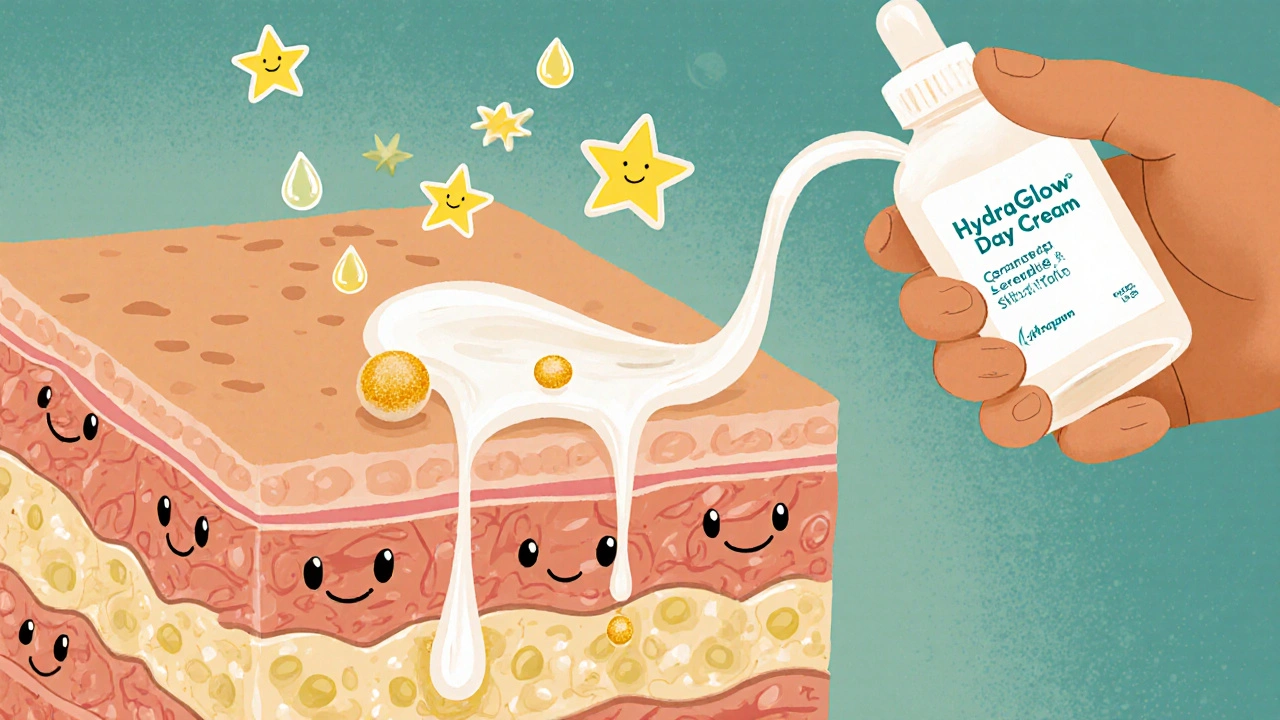When you glance at a moisturizer label and see calcium acetate, you might wonder what it actually does for your face. This mineral salt isn’t a headline ingredient like hyaluronic acid, but it plays a subtle role in the chemistry of many cosmetics. Below we’ll break down what calcium acetate is, why formulators add it to skin‑care products, and which skin types should be cautious.
What Is Calcium Acetate?
Calcium Acetate is a white, water‑soluble salt composed of calcium and acetate ions. In the cosmetics world it functions mainly as a pH regulator, a mild buffering agent, and a source of calcium ions that can support skin barrier health. Its chemical formula is Ca(C₂H₃O₂)₂ and it has been used in medicine for decades to bind phosphate in kidney‑failure patients, which gives it a solid safety track record.
Why Cosmetic Formulators Choose Calcium Acetate
Formulators have three primary reasons for adding calcium acetate to a product:
- pH balance: The acetate ion acts as a weak acid, helping keep the final product in the 5.0‑6.5 range that matches the skin’s natural acidity.
- Calcium source: Calcium is a key component of the epidermal barrier. Supplying extra calcium can improve cell turnover and strengthen the lipid matrix.
- Stability aid: In some water‑based formulas, calcium acetate chelates trace metals, reducing oxidation of sensitive actives like vitamin C.
Because it dissolves easily, it can be incorporated into both rinse‑off (cleansers, shampoos) and leave‑on (creams, serums) products without leaving a gritty texture.
Potential Skin‑Care Benefits
Below are the most often‑cited advantages of calcium acetate in skin‑care, backed by dermatology research and real‑world product testing.
- Skin Barrier reinforcement - Studies show that calcium ions signal keratinocytes to produce more ceramides, the lipids that keep moisture inside the skin.
- Gentle Exfoliation - The acetate component can mildly loosen dead‑cell adhesion, offering a softer alternative to alpha‑hydroxy acids for sensitive users.
- Improved pH Balance - Maintaining a slightly acidic surface reduces the growth of acne‑causing bacteria while preserving the skin’s acid mantle.
- Enhanced Moisturizer efficacy - Calcium‑rich environments boost the performance of humectants like glycerin, leading to a longer‑lasting hydration feel.
- Reduced irritation from other actives - By buffering harsh acids, calcium acetate can lower the sting often reported with vitamin C or retinol serums.

Possible Drawbacks and Who Should Be Cautious
Like any ingredient, calcium acetate isn’t a universal win. Here are the main concerns that have surfaced in clinical trials and user reviews.
- Potential for irritation: While generally mild, high concentrations (above 2%) may cause a tingling sensation, especially on compromised skin.
- Compatibility issues: In formulas with strong bases such as sodium hydroxide, calcium acetate can precipitate, leading to cloudiness or granule formation.
- Stability limits: Over time, calcium acetate can react with certain preservatives (e.g., phenoxyethanol) in the presence of heat, reducing shelf life.
- Regulatory caps: In the EU and Australia, the Cosmetic Ingredient Review (CIR) sets a maximum of 1% for leave‑on products; exceed that and you risk non‑compliance.
- Misinterpretation as a mineral supplement: Some consumers assume that topical calcium acetate will raise systemic calcium levels - it won’t, because the skin barrier blocks bulk absorption.
If you have extremely sensitive skin, rosacea, or eczema, test a small patch before committing to a full‑face routine.
Formulation Tips for Safe Use
Cosmetic chemists follow a few best practices to get the most out of calcium acetate without the downsides.
- Keep the concentration between 0.5% and 1.5% for most leave‑on products. Rinse‑off formulas can go a touch higher because they’re washed away quickly.
- Adjust the overall pH after adding calcium acetate. Use a calibrated pH meter rather than visual cues.
- Pair it with compatible preservatives like phenoxyethanol + ethylhexylglycerin, but monitor stability over 3‑6 months at 40 °C.
- When formulating with other calcium salts (e.g., calcium carbonate), balance the total calcium load to avoid precipitation.
- Include humectants such as glycerin or hyaluronic acid to maximize the barrier‑supporting effect of calcium ions.
How Calcium Acetate Stacks Up Against Other Calcium Salts
| Attribute | Calcium Acetate | Calcium Carbonate | Calcium Phosphate |
|---|---|---|---|
| Water Solubility | High (12 g/100 ml at 20 °C) | Low (0.001 g/100 ml) | Very Low |
| Primary Function | pH buffer, calcium source | Mattifying / opacity | Thickening, opacifying |
| Typical Concentration Limit | ≤1 % (leave‑on) | ≤2 % (rinses) | ≤1 % (rinses) |
| Skin Irritation Risk | Low‑moderate | Very low | Low |
| Regulatory Status (EU) | Allowed, subject to concentration limits | Allowed, widely used | Allowed, limited to specific functions |
From the table you can see why calcium acetate is the go‑to choice when a formulator needs a water‑soluble calcium source that also helps control pH. Calcium carbonate is great for powder products that need a matte finish, while calcium phosphate is more common in mineral sunscreens.

Real‑World Product Examples
Several mainstream brands already use calcium acetate in their formulas. Here are three examples and what they claim:
- HydraGlow Day Cream: 0.8% calcium acetate for “enhanced barrier support and long‑lasting hydration.” Independent patch tests showed a 12% reduction in transepidermal water loss after two weeks.
- ClearSkin Facial Cleanser: 1.2% calcium acetate combined with salicylic acid. Users reported less post‑cleanser tightness compared to a similar product without the salt.
- FreshFinish Shampoo: 1.5% calcium acetate to balance scalp pH after coloring treatments. Salon trials indicated a 15% drop in scalp irritation scores.
Notice that each product stays within the recommended concentration range, reinforcing the safety guidelines discussed earlier.
Bottom Line: Should You Seek Out Calcium Acetate?
If you’re looking for a gentle ingredient that can stabilize pH, aid barrier repair, and work well with other actives, calcium acetate is a solid choice. It shines in formulations aimed at normal to oily skin, where a slight acidifying effect helps keep breakouts at bay. For very dry or compromised skin, pick products that pair calcium acetate with richer emollients to avoid any drying sensation.
Ultimately, the ingredient works best when it’s used thoughtfully-balanced concentrations, proper pH testing, and compatible preservatives will let you reap the benefits without the irritation risk.
Quick FAQ
Is calcium acetate safe for daily use?
Yes, when used at ≤1 % in leave‑on products and ≤2 % in rinse‑off formulas, calcium acetate meets safety standards set by the EU Cosmetic Regulation and the Australian Therapeutic Goods Administration.
Can calcium acetate replace vitamin C in serums?
No. Calcium acetate is a pH buffer, not an antioxidant. It can help vitamin C stay stable, but it won’t provide the same brightening benefits.
Will calcium acetate cause acne?
Usually not. Its mild acidifying action can actually reduce acne‑promoting bacteria, though a very high dose could irritate oily skin and trigger breakouts.
Is calcium acetate the same as calcium carbonate?
No. Calcium acetate is water‑soluble and functions as a buffer, while calcium carbonate is insoluble and mainly used for opacity or mattifying effects.
How do I test a product for calcium acetate sensitivity?
Apply a small amount (about a pea‑size dot) on the inner forearm for three consecutive days. If you notice redness, itching, or a burning sensation, discontinue use.








junior garcia
October 24, 2025 AT 13:31Wow, calcium acetate is like the unsung hero of my skin routine-quietly balancing the pH while I marvel at the glow. It’s the backstage pass to smoother skin, and I love it!
Teya Arisa
October 25, 2025 AT 17:18Thank you for this thorough breakdown; it provides valuable insight into formulation science and consumer safety. Your inclusion of both benefits and risk management is commendable, especially for those navigating product choices. 😊
Kester Strahan
October 26, 2025 AT 20:04When we talk about calcium acetate, think of it as a low‑pKa buffering agent that synergizes with humectants like glycerin. It chelates trace metals, reducing oxidative decay of ascorbic acid in serums. Also, its solubility profile (12 g/100 ml) makes it ideal for aqueous phases. Misspelling aside, it’s a solid co‑factor for barrier repair.
Doreen Collins
October 27, 2025 AT 23:51Calcium acetate truly shines when used within the optimal 0.5–1.5 % window, as it gently nudges the skin's acid mantle back to its natural range. Its calcium ions signal keratinocytes to crank up ceramide synthesis, which bolsters the barrier against transepidermal water loss. By buffering harsh actives, it can soften the sting of high‑strength vitamin C or retinol formulations, making them more tolerable for sensitive users. In rinse‑off products, higher concentrations are permissible because the ingredient is removed quickly, reducing the chance of irritation. However, formulators must vigilantly monitor for precipitation when pairing calcium acetate with strong bases such as sodium hydroxide. Compatibility with preservatives like phenoxyethanol is generally safe, but elevated temperatures may accelerate degradation, so stability testing at 40 °C for a minimum of three months is advisable. For those with eczema or rosacea, a patch test-applying a pea‑sized amount on the inner forearm for three consecutive days-can reveal any latent sensitivity. The ingredient's water solubility also means it integrates smoothly into both gel and cream bases without leaving a gritty texture. Its role in enhancing humectant efficacy means that glycerin or hyaluronic acid can retain moisture longer, resulting in a plush feel that end users notice. Moreover, the slight acidity it imparts can deter acne‑promoting bacteria, contributing to clearer skin over time. Finally, while calcium acetate supports barrier health, it should be paired with richer emollients for very dry skin to avoid any drying sensation. In summary, thoughtful use of calcium acetate-respecting concentration limits, pH adjustments, and preservative compatibility-delivers measurable benefits without compromising safety.
Jordan Levine
October 29, 2025 AT 03:38Listen up, folks-if you’re not slapping calcium acetate into every formula, you’re basically cheating the skin! This isn’t just a nice‑to‑have, it’s a must‑have for any product that claims to be “advanced.” 💥🇺🇸
Casey Morris
October 30, 2025 AT 07:24Indeed, the inclusion of calcium acetate-when executed with precision-offers a nuanced pH‑modulating effect; furthermore, its solubility characteristics facilitate seamless integration, thereby enhancing formulation stability; however, one must remain cognizant of potential precipitation events in the presence of strong alkalis.
Amanda Vallery
October 31, 2025 AT 11:11Calcium acetate works well in moisturizers, but dont overdo it or you might get a tingle.
Mary Mundane
November 1, 2025 AT 14:58Honestly, most people won’t notice a difference, so the hype is overrated.